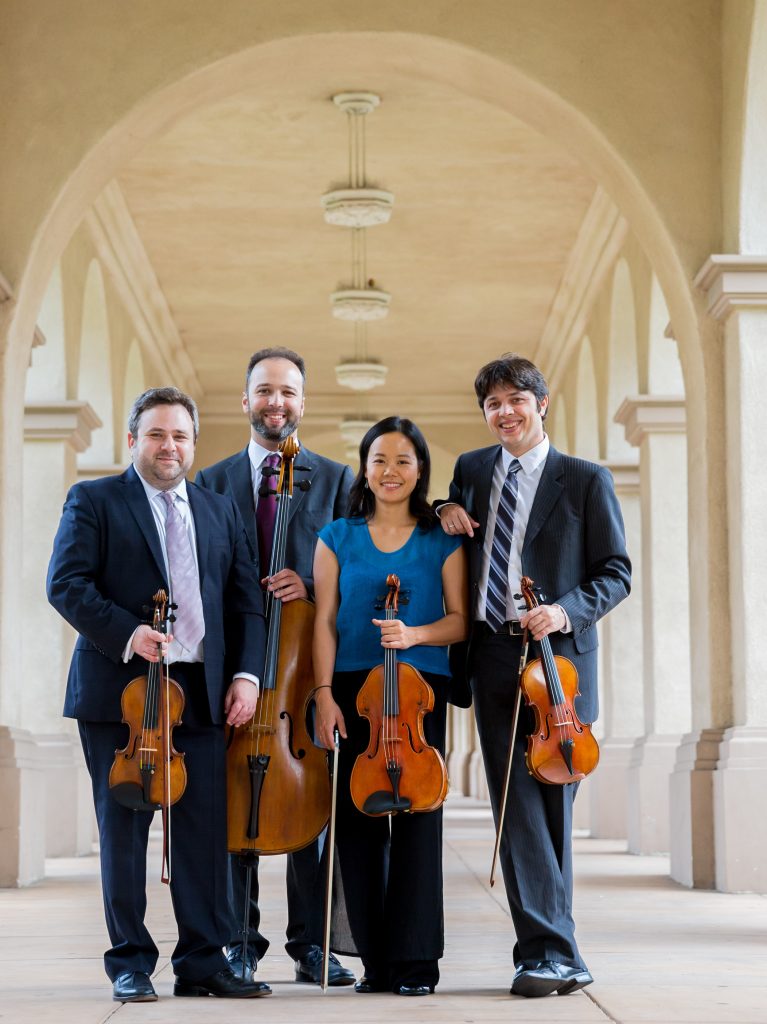Hausmann Takes Bartók’s Third Quartet on the Most Recent Haydn Voyage
I have been covering the Hausmann Quartet’s Haydn Voyages Series since 2017, and I feel it is time to make a confession. I attend these concerts regularly not because I am a fan of Franz Joseph Haydn’s string quartets—in truth, I can take them or leave them. But I eagerly return because in every program, Hausmann complements their requisite pair of Haydn string quartets with other works for quartet, typically contemporary pieces and gems from the 20th century. And these discoveries have seldom disappointed my expectations.

Hausmann Quartet: Bram Goldstein, Alex Greenbaum, Angela Choong & Isaac Allen [photo courtesy of Hausmann Quartet]
A wistful viola solo, played with supple grace by Angela Choong, opens the middle section, a prelude to this mellow interlude that suggests a tranquil Midwest prairie scene from the composer’s youth. To complete “Middleground,” Washington returns to the busy ostinatos of the opening, but now with heightened intensity. This is one of Washington’s most popular works, and several versions can easily be found online.
Bartók biographer Kenneth Chalmers has recounted the Third String Quartet’s unexpected American connection. Although the composer finished the quartet in the fall of 1927 in Budapest, he sent the score to a competition sponsored by the Philadelphia Music Fund Society. It was awarded first prize, so the work’s first performance was given in Philadelphia in December of 1928.
Chalmers notes that by the mid-1920s, Bartók had become aware of Alban Berg’s early string quartet Lyric Suite and Stravinsky’s post-war neoclassical works, and the Third Quartet shows that he learned a few things from his competition. But his 1927 String Quartet still displays his iconic traits: small, intense motifs constantly manipulated and layered in dense textures; quickly changing meters; unresolved dissonances, and dark, modal themes. In the opening movement, second violin Bram Goldstein earnestly crafted the primary theme, which violist Choong confidently extended. First violinist Isaac Allen communicated the flinty edge of the second movement’s driving theme that appears to allude to the bouncy, peripatetic main theme of Stravinsky’s The Soldier’s Tale. The discrete islands of sound in the slow third movement made me wonder if later composer Mauricio Kagel used this as a template for his characteristic chamber music. The anxious, highly accented lines of the Third Quartet’s rapid finale embody the composer’s disciplined athleticism, which Hausmann conveyed with commendable flair.
Haydn’s Quartet in E-flat Major, Op. 64, No. 6, completed in 1790, shows the composer at the height of his melodic and structural prowess, just as he was about to undertake his crowning symphonic works, the 12 London Symphonies. Hausmann’s extensive experience with the canon of Haydn’s string quartets–they have played more than half of his 60-plus quartets on their Haydn Voyages series–gave a confident, polished account of Opus 64, No. 6. I admired their eloquently detailed delivery of the opening movement’s suave cantabile themes that morph into a clever fughetta as well as the rich sonority of their second movement, Andante, led by cellist Alex Greenbaum’s delectable flights in his instrument’s highest range. They gave an appropriately stately air to the Menuet, and they indulged the Finale‘s disciplined frolic with ample elation.
Hausmann opened their concert with an early Haydn Quartet, the D Major, Op. 17, No. 6. Like many of his early quartets, this one requires the first violin to do most of the heavy lifting, and the middle movements even suggest sketches for a violin concerto. Isaac Allen carried out his responsibilities with his customary lyrical grace and verve.
The Hausmann Quartet presented this concert, part of its 2022 Haydn Voyages series, on May 8, 2022, at the Maritime Museum of San Diego on San Diego Bay.

Ken Herman, a classically trained pianist and organist, has covered music for the San Diego Union, the Los Angeles Times’ San Diego Edition, and for sandiego.com. He has won numerous awards, including first place for Live Performance and Opera Reviews in the 2017, the 2018, and the 2019 Excellence in Journalism Awards competition held by the San Diego Press Club. A Chicago native, he came to San Diego to pursue a graduate degree and stayed.Read more…
